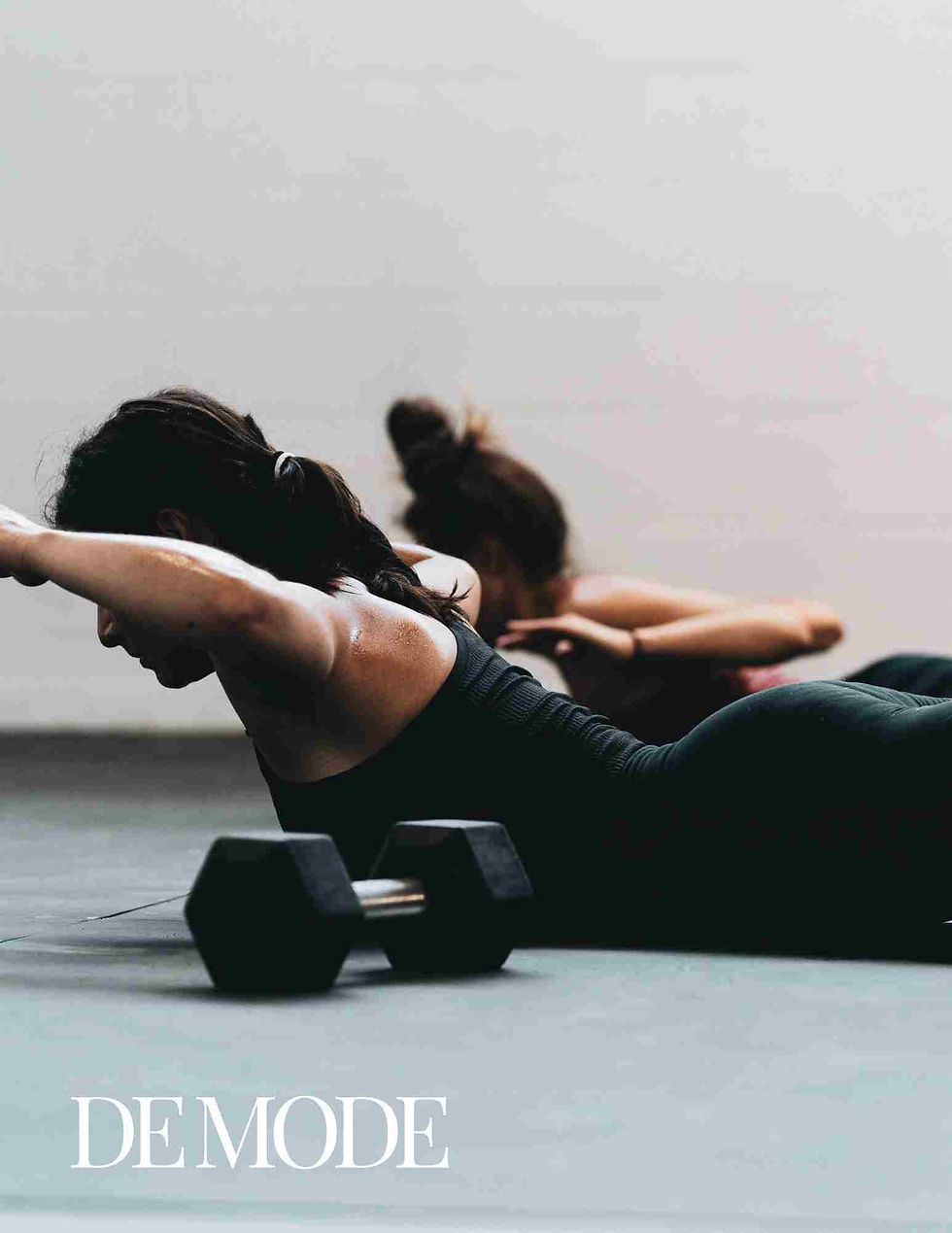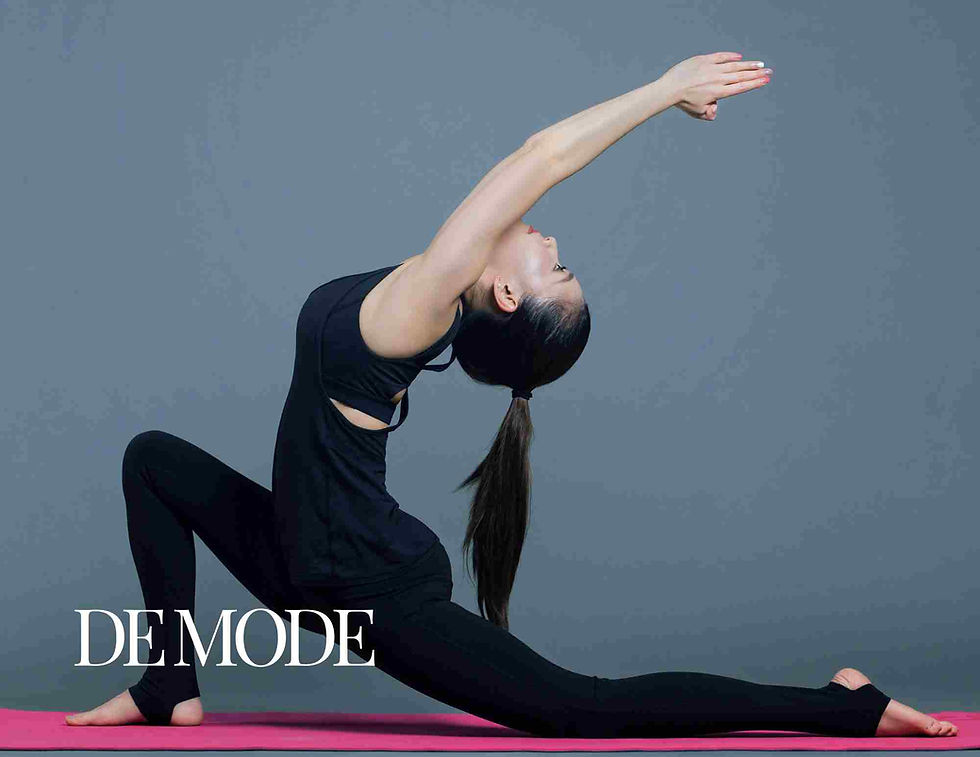"THE POWER OF PILATES - CORE STRENGTH AND STABILITY": DE MODE GLOBAL
- DE MODE

- Jun 22, 2024
- 5 min read
ORIGINALLY PUBLISHED IN DE MODE | FITNESS
Article Published on: 22ND JUNE 2024 | www.demodemagazine.com
Pilates, a form of exercise developed by Joseph Pilates in the early 20th century, has gained widespread popularity due to its focus on core strength, stability, and overall body conditioning. This method emphasizes controlled movements, precision, and mindful breathing, making it an effective workout for improving physical fitness and enhancing mental well-being. In this article, we delve into the principles of Pilates, the benefits of core strength and stability, and tips for incorporating Pilates into your fitness routine.
The Principles of Pilates
Pilates is built on six fundamental principles that guide its practice: concentration, control, center, flow, precision, and breathing. These principles form the foundation for performing Pilates exercises effectively and safely.
Concentration: Pilates requires complete focus on each movement. This mindfulness enhances body awareness and ensures that exercises are performed with intention and accuracy.
Control: Each Pilates exercise is performed with controlled, deliberate movements. This principle, known as "contrology" by Joseph Pilates, minimizes the risk of injury and maximizes the effectiveness of each movement.
Center: The core, or "powerhouse," is the center of all Pilates movements. Strengthening the core muscles, including the abdominals, lower back, hips, and glutes, provides stability and support for the entire body.
Flow: Pilates exercises are performed in a flowing sequence, with smooth transitions between movements. This fluidity enhances coordination and promotes a balanced workout.
Precision: Emphasis on precise movements ensures that each exercise targets the intended muscles. Precision improves muscle efficiency and alignment, contributing to overall body symmetry and balance.
Breathing: Proper breathing techniques are integral to Pilates. Deep, controlled breaths oxygenate the muscles, support movement, and aid in concentration and relaxation.

Benefits of Core Strength and Stability
Core strength and stability are central to Pilates and offer numerous benefits for physical health and performance. Here’s a closer look at how a strong and stable core can enhance your overall well-being:
Improved Posture: A strong core supports the spine and promotes proper alignment, reducing the risk of developing poor posture. Good posture alleviates strain on the back, neck, and shoulders, preventing chronic pain and discomfort.
Enhanced Balance and Coordination: Core stability improves balance and coordination, essential for daily activities and athletic performance. A stable core provides a solid foundation for movement, reducing the likelihood of falls and injuries.
Increased Flexibility: Pilates incorporates stretching and lengthening exercises that enhance muscle flexibility and joint mobility. A flexible core allows for a greater range of motion, improving overall physical performance.
Better Movement Efficiency: A strong core facilitates efficient movement by stabilizing the body and allowing for smooth, controlled actions. This efficiency reduces the risk of overuse injuries and enhances endurance.
Reduced Back Pain: Core strengthening exercises in Pilates target the deep abdominal and back muscles that support the spine. Strengthening these muscles can alleviate and prevent lower back pain, a common issue for many individuals.
Enhanced Athletic Performance: Athletes benefit from a strong core, as it improves power, speed, and agility. Core stability enables better control of movements, contributing to improved performance in sports and physical activities.
Pilates Exercises for Core Strength and Stability
Pilates offers a variety of exercises that target the core muscles. Here are some key exercises to incorporate into your routine:
The Hundred: This classic Pilates exercise warms up the body and engages the core. Lie on your back with your legs raised to a tabletop position. Lift your head, neck, and shoulders off the mat, and extend your arms alongside your body. Pump your arms up and down while breathing in for five counts and out for five counts, completing 100 pumps.
Roll-Up: The Roll-Up stretches the spine and strengthens the abdominals. Lie on your back with your arms extended overhead. Inhale as you lift your arms toward the ceiling and begin to roll up through your spine, reaching for your toes. Exhale as you roll back down, articulating through each vertebra.
Plank: Plank exercises engage the entire core. Start in a push-up position with your hands directly under your shoulders and your body in a straight line from head to heels. Hold this position, engaging your abdominal muscles and maintaining a neutral spine.
Single-Leg Stretch: This exercise targets the lower abdominals and improves coordination. Lie on your back with your knees bent and your shins parallel to the floor. Lift your head, neck, and shoulders off the mat. Extend one leg while pulling the opposite knee toward your chest, then switch legs in a scissor-like motion.
Teaser: The Teaser challenges balance and core strength. Sit with your knees bent and feet flat on the floor. Lean back slightly, lifting your legs into a tabletop position. Extend your legs and arms to form a V shape with your body, then lower back down with control.
Side Plank: Side Plank strengthens the obliques and enhances lateral stability. Lie on your side with your legs stacked. Prop yourself up on your elbow, aligning it directly under your shoulder. Lift your hips, creating a straight line from head to heels. Hold this position, engaging the side body.

Tips for Incorporating Pilates into Your Fitness Routine
Start with a Beginner Class: If you’re new to Pilates, begin with a beginner class to learn the foundational principles and basic exercises. This ensures that you perform the movements correctly and safely.
Consistency is Key: Consistent practice is essential for reaping the benefits of Pilates. Aim to incorporate Pilates into your routine at least 2-3 times per week.
Focus on Form: Proper form and alignment are crucial in Pilates. Concentrate on performing each movement with precision, rather than rushing through the exercises.
Use Props: Pilates props such as resistance bands, Pilates rings, and stability balls can add variety and challenge to your workouts. These tools help target different muscle groups and enhance overall strength and flexibility.
Listen to Your Body: Pay attention to how your body feels during and after your Pilates practice. If you experience pain or discomfort, modify the exercises or consult a certified Pilates instructor for guidance.
Integrate Pilates with Other Workouts: Pilates complements other forms of exercise, such as cardio and strength training. Incorporating Pilates into a balanced fitness routine can enhance overall physical performance and prevent injury.
Progress Gradually: As you become more comfortable with Pilates, gradually increase the intensity and complexity of your workouts. Challenge yourself with advanced exercises to continue building strength and stability.

Conclusion: Embrace the Power of Pilates
Pilates offers a powerful approach to building core strength and stability, with benefits that extend beyond the physical body. By focusing on controlled movements, mindful breathing, and precise alignment, Pilates enhances posture, balance, flexibility, and overall movement efficiency. Whether you’re a beginner or an experienced practitioner, incorporating Pilates into your fitness routine can transform your body and mind, leading to improved well-being and a higher quality of life.
Embrace the power of Pilates and experience the transformative effects of a strong and stable core. With consistent practice and dedication, you’ll discover greater strength, flexibility, and mental clarity, empowering you to navigate life with confidence and ease.



Comentarios